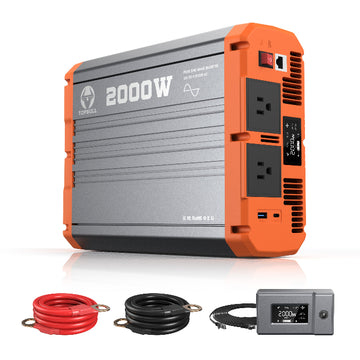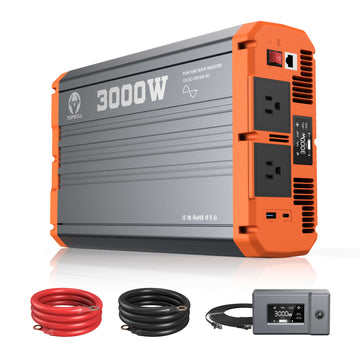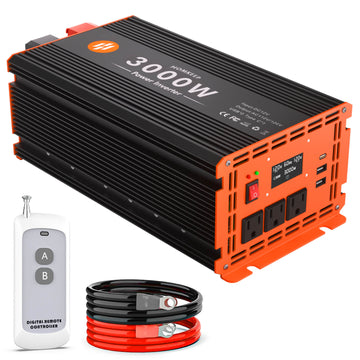Switching to solar energy is a smart investment for homeowners looking to cut electricity bills and reduce reliance on the grid. But one crucial component of any solar power system—the solar inverter—can vary widely in price.
So, how much does a solar inverter cost? What factors influence its price, and how can you choose the best option for your budget? In this complete guide, we'll break down solar inverter costs, key pricing factors, and tips to make an informed decision. Whether you're installing a new system or upgrading an existing one, this article will help you understand what to expect.
If you are looking for the prices of power inverters, then check out this post for details and buying tips: How Much Does A Power Inverter Cost: Smart Buying Tips
Basics of Solar Inverters
If you're new to solar energy, let's start with the basics of solar inverters. So, what does a solar inverter do? In simple terms, a solar inverter converts the DC electricity produced by solar panels into AC electricity, which can be used by household appliances or fed into the grid.

There are three main types of solar power systems, each requiring a specific type of inverter:
-
Off-grid systems: These systems operate independently from the utility grid and rely on batteries for energy storage. Off-grid inverters are designed to work with battery banks, ensuring continuous power supply even when sunlight is unavailable.
-
Grid-tied systems: These systems are connected to the utility grid and do not require battery storage. Grid-tie inverters convert DC power from solar panels into AC power that matches the grid's voltage and frequency, allowing homeowners to feed excess energy back into the grid.
- Hybrid systems: A hybrid system combines elements of both off-grid and grid-tied setups. It uses a hybrid inverter that can switch between grid connection and battery storage, offering greater energy independence and backup power during outages.
Understanding the differences between these systems will help you choose the right inverter for your needs. In the next section, we'll break down the costs associated with different types of solar inverters.
More to Discover About Inverters:
What is an Inverter: Ultimate Guide to Understand Inverters
12V to 120V Inverter: How It Works & What You Need to Know
Costs of Solar Inverters by Types
The cost of a solar inverter varies depending on its type and function. Below are the most common inverter types used in both grid-tied and off-grid solar systems, along with their price ranges, benefits, and drawbacks.
Battery-Based Inverters
Best for: Homeowners seeking energy independence, those in remote locations, or users needing reliable backup power.
Battery-based inverters convert DC electricity from battery storage into AC power for household or grid use. They are essential for off-grid systems and also provide backup power when there are power outrages.
| Applications | - Solar energy storage systems - Home backup power during outages - Off-grid power solutions - RVs, boats, and remote cabins - Uninterruptible power supplies (UPS) |
| Average Prices | - Small (1-3kW): $200 - $800 - Medium (3-6kW): $600 - $1,000 - Large (6-10kW): $1,000 - $25,000 |
| Pros | - Enables energy storage for night-time or emergencies - Reduces reliance on the grid - Provides backup power during outages |
| Cons | - Higher upfront cost - Battery lifespan and capacity limitations - More complex installation compared to grid-tied inverters |
String Inverters
Best For: Homes with uniform solar panel orientation, no shading issues, and budget-conscious users.
String inverters convert DC electricity from a series-connected string of solar panels into AC power for household or grid use. They are the most common and cost-effective option for residential and commercial solar installations.
| Applications | - Residential solar systems - Commercial solar installations - Ground-mounted solar arrays - Grid-tied systems |
| Average Prices | - Small (3-5kW): $1,000 - $1,800 - Medium (6-10kW): $1,500 - $3,000 - Large (10-30kW): $2,500 - $4,000+ |
| Pros | - Lower initial cost compared to other inverter types - Proven, efficient technology (96-98%) - Centralized monitoring for easy maintenance |
| Cons | - A single failure can shut down the entire system - Shading on one panel reduces the performance of the entire string - Less flexible for installations with multiple roof angles |
Microinverter
Best For: Homes with shading issues, complex roof layouts, or users prioritizing system monitoring and flexibility.
Microinverters convert DC to AC at the panel level, ensuring independent operation of each solar panel. This improves performance, especially in shaded or complex installations.
| Applications | - Residential solar systems - Systems with shading or multiple roof orientations - Roofs with space constraints - Installations requiring per-panel monitoring |
| Average Prices | - Per panel (215-350W): $120 - $180 - For a typical home (20 panels): $2,400 - $3,600 - With installation: $3,500 - $5,000 |
| Pros | - Maximizes efficiency with per-panel MPPT optimization - No single point of failure - Easier system expansion |
| Cons | - Higher initial cost than string inverters - More components, increasing maintenance complexity - Requires more labor-intensive installation |
Hybrid Inverter
Best For: Homeowners planning to add battery storage, those in regions with time-of-use electricity rates, or areas with unreliable grid service.
Hybrid inverters combine the functions of grid-tied and battery-based inverters, allowing solar power to be used, stored, or fed into the grid based on demand.
| Applications | - Solar + battery storage systems - Self-consumption optimization - Backup power solutions - Time-of-use electricity rate management |
| Average Prices | - Small (3-5kW): $1,000 - $2,000 - Medium (5-8kW): $3,000 - $5,000 - Large (8-15kW): $5,000 - $9,000 |
| Pros | - Integrated storage capability - Flexible power management - Future-proof for battery additions |
| Cons | - More expensive than traditional grid-tied inverters - May have compatibility limitations with certain battery brands - More complex setup and configuration |
Factors Affecting the Cost of Solar Inverters
Inverter prices rise with the increasing complexity of the tech involved, including factors such as power capacity, efficiency, and any additional features involved. Here are the key factors that influence cost:
- System Type: Off-grid inverters are more expensive than grid-tied models as they require energy storage, multiple power inputs, and independent operation without grid support.
- Power Capacity: Higher wattage inverters cost more; for example, a 4,000W inverter is significantly pricier than a 2,000W model due to increased power handling.
- Efficiency: More efficient inverters (97-99%) reduce energy losses and improve system performance but tend to be more expensive upfront.
- Technology & Features: Advanced inverters with MPPT, remote monitoring, Wi-Fi connectivity, LCDs, and smart grid compatibility come at a premium.
- Brand & Reputation: Well-known brands charge more for reliability and quality, but lesser-known brands may offer similar performance at a lower cost.
- Warranty & Maintenance: String inverters usually have a 5-10 year warranty, while microinverters and hybrid models offer 10-25 years. Although microinverters have a higher upfront cost, their modular design reduces long-term maintenance expenses.
Recommend: Best Value Solar Inverters to Pick
If you're looking for a reliable solar inverter, TOPBULL's pure sine wave inverters are great for off-grid solar systems, home backup power, and reducing grid dependency. These inverters offer stable performance, multiple safety features, and versatile connectivity options.
Why Choose TOPBULL?
-
Reliable & Stable – Provides clean and consistent power for a variety of applications.
-
High Performance – Handles peak surges up to 8000W, making it ideal for power-hungry devices.
-
Enhanced Safety – Features built-in protection against overload, overheating, and short circuits.
-
User-Friendly – Comes with an LCD, silent cooling fan, and multiple output options.
- Versatile Applications – Perfect for home backup, RVs, boats, workshops, and remote locations.
The following are the 3 most popular pure sine power inverter models. You can choose the one that suits you according to your needs.
| Feature | Topbull 2000W | Topbull 3000W | Topbull 4000W |
| Continuous Power | 2000W | 3000W | 4000W |
| Peak Power | 4000W | 6000W | 8000W |
| Efficiency | Over 90% | Over 90% | Over 90% |
| Protection System | ✅ Multiple safety features (overload, overheat, short circuit) | ✅ Multiple safety features (overload, overheat, short circuit) | ✅ Multiple safety features (overload, overheat, short circuit) |
| Outlets | 2x US AC, 1x USB-C, 1x USB | 2x US AC, 1x USB-C, 1x USB | 2x US AC, 1x USB-C, 1x USB |
| Applications | Home backup, RVs, small off-grid setups | Medium-sized off-grid homes, workshops, boats | Large off-grid homes, commercial use, industrial backup |

FAQs About Solar Inverter Prices
Q1 What is the lifespan of a solar inverter?
The lifespan of a solar inverter depends on the type of unit. String inverters typically last 10-15 years before needing replacement, while microinverters can come with 25-year warranties, offering long-term reliability and often lasting 20-25 years. Microinverters are a significant investment for those looking for longevity.
Q2 How to choose a solar inverter?
Instead of relying on a general recommendation, evaluate your unique needs and requirements. Consider the following factors when choosing a solar inverter:
1. Power matching: Determine the number of appliances you'll need to power, and select an inverter size that matches or slightly exceeds your system's power output.
2. Efficiency: Aim for an inverter with over 90% efficiency. For high-efficiency inverters, string inverters typically range from 96-98% efficiency.
3. Reliability: Choose a reputable brand that offers solid warranty terms, high build quality, and strong customer service. Look for certifications like CE, FCC, and ROHS for added assurance.
4. Functional requirements: Identify the type of inverter based on your system setup (e.g., string, micro, hybrid, or battery-based) and specific needs (e.g., backup power, off-grid systems).
Conclusion
In this guide, we've explored the factors influencing the cost of solar inverters and provided insights into choosing the right one for your needs. Always start by identifying your power requirements before making a decision. If you're looking for a dependable off-grid inverter, TOPBULL's solar power inverters range of efficient, versatile, and reliable solar power inverters is an excellent choice that ensures long-term performance and peace of mind.













